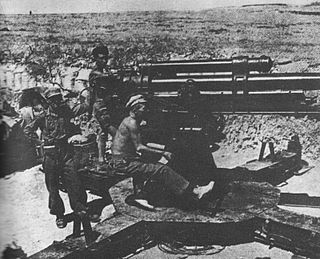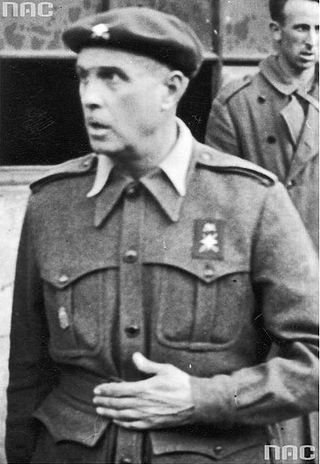
The Battle of the Ebro was the longest and largest battle of the Spanish Civil War and the greatest, in terms of manpower, logistics and material ever fought on Spanish soil. It took place between July and November 1938, with fighting mainly concentrated in two areas on the lower course of the Ebro River, the Terra Alta comarca of Catalonia, and the Auts area close to Fayón (Faió) in the lower Matarranya, Eastern Lower Aragon. These sparsely populated areas saw the largest array of armies in the war. The battle was disastrous for the Second Spanish Republic, with tens of thousands left dead or wounded and little effect on the advance of the Nationalists.

Juan Guilloto León, usually referred to as Modesto or Juan Modesto, was a Republican army officer during the Spanish Civil War.

Enrique Líster Forján was a Spanish communist politician and military officer.
The Second Battle of the Corunna Road was a battle of the Spanish Civil War that took place from 13 December 1936 to 15 January 1937, northwest of Madrid. In December 1936, the Nationalists launched an offensive in order to cut the Corunna Road and isolate Madrid, but a Republican counter-offensive stopped the Nationalist advance. The Nationalists cut the Corunna road but failed to encircle Madrid.

The Aragon Offensive was an important military campaign during the Spanish Civil War, which began after the Battle of Teruel. The offensive, which ran from March 7, 1938, to April 19, 1938, smashed the Republican forces, overran Aragon, and conquered parts of Catalonia and the Levante.

José Solchaga Zala was a Spanish general who fought for the Nationalists in the Spanish Civil War.

The International Brigades (IB) were volunteer military units of foreigners who fought on the side of the Second Spanish Republic during the Spanish Civil War. The number of combatant volunteers has been estimated at between 32,000–35,000, though with no more than about 20,000 active at any one time. A further 10,000 people probably participated in non-combatant roles and about 3,000–5,000 foreigners were members of CNT or POUM. They came from a claimed "53 nations" to fight against the Spanish Nationalist forces led by General Francisco Franco and assisted by German and Italian forces.

The XI International Brigade fought for the Spanish Second Republic in the Spanish Civil War.

The Asturias Offensive was an offensive in Asturias during the Spanish Civil War which lasted from 1 September to 21 October 1937. 45,000 men of the Spanish Republican Army met 90,000 men of the Nationalist forces.

The Battle of Seseña was Republican-Soviet assault on the Nationalist stronghold of Seseña, near Toledo, 30 km south of Madrid in October 1936 during the Spanish Civil War. After the fall of Talavera de la Reina and Toledo in September 1936, the Nationalist troops pushed towards Madrid and in October they were 30 km from the city. The Republican government which had received new Soviet weapons decided to launch a counteroffensive in order to stop the Nationalist offensive at Seseña. The attack failed and the Nationalists resumed their advance towards Madrid. The battle is notable for being the first time that massive tank warfare was seen in the Spanish War and for the use by Nationalist troops of Molotov cocktails against Soviet T-26 tanks.
The Battle of Lopera took place between 27 and 29 December 1936 during the Spanish Civil War. This battle took place during the Nationalist's Aceituna offensive. On 27 December, the XIV International Brigade launched an attack in order to occupy the Nationalist-held town of Lopera, but the attack failed after two days and the Brigade suffered appalling casualties.

The Segovia Offensive was a Republican diversionary offensive which took place between 31 May and 6 June 1937, during the Spanish Civil War. The main goal of the offensive was to occupy Segovia and divert Nationalist forces from their advance on Bilbao. After a brief initial advance the offensive failed due to Nationalist air superiority.
The Huesca Offensive was an ill-fated Republican army thrust toward Huesca between 12 and 19 June 1937, during the Spanish Civil War. Hungarian writer and communist commander Máté Zalka was killed in the course of the battle.
The Battle of Alfambra took place near Alfambra from 5 to 8 February 1938, during the Spanish Civil War. This battle was a part of the Battle of Teruel. After, the conquest of Teruel by the Republican army, the Nationalists started a counteroffensive in order to reocuppy Teruel. On 5 February a huge nationalist force broke the republican lines north of Teruel towards the Alfambra river, taking 7,000 republican prisoners and threatening the Republican forces in Teruel.
The Battle of Caspe took place during the Aragon Offensive of the Spanish Civil War in 16–17 March 1938.

The Cartagena uprising took place 4–7 March 1939 during the Spanish Civil War. The troop transport SS Castillo de Olite was sunk during the revolt.
Luis Barceló Jover was a Spanish military officer.
The Servicio de Información Militar or SIM was the political police of the Spanish Republican Armed Forces from August 1937 to the end of the Spanish Civil War.
Fernando Barrón y Ortiz (1892–1952) was a Spanish military officer. One of the five commanders of the natives troops in Africa, he supported the military coup of July 1936 which started the Spanish Civil War. Later, he was one of the commanders of the Spanish Army of Africa in its advance towards Madrid. In November 1936 led the nationalist attack against the Madrid's suburb of Carabanchel. In December 1936 he led one of General Varela's mobile columns in the Second battle of the Corunna Road. In January 1937 he led a brigade in the Battle of Jarama. In May 1937, he took part in the nationalist counteroffensive during the Segovia Offensive. In June 1937, he led the 13th division in the Battle of Brunete in August in the Battle of Belchite and in March 1938 in the Battle of Caspe. During the Battle of the Ebro he led the Nationalist defense of the town of Gandesa. After the war, he was a minister of the Francoist government.

The CL International Brigade or 150th International Brigade, also known as "Dabrowski Brigade", was a military unit of the International Brigades during the Spanish Civil War. Its members were mostly Polish, but there was also a Spanish battalion, as well as a Hungarian section.












